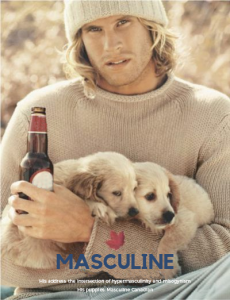Original Advertisement
I chose to analyze and alter via culture jamming an advertisement of Molson Canadian beer that appeared in the Cosmopolitan magazine. The poster depicts a male model cradling two puppies while holding an open bottle of Molson beer in his hand. Underneath the Molson logo reads “His Address: The intersection of confidence and compassion. His Beer: Molson Canadian.” This advertisement idealizes “soft and sensitive” masculinity by placing delicate golden retrievers in the arms of an overtly mainstream “masculine” man (Wade). The purpose of the poster seems to be for viewers to associate the supposedly desired masculinity that is portrayed by the model in the poster with Molson Canadian beer.
While the advertisement was placed in the Cosmopolitan magazine which is directed towards young female readers, it was not meant for consumer purposes but rather as a means to further depict Molson as a masculine drink. This is evident as the advertisement was also featured in the male targeted magazines of Playboy and FHM as part of an article that explains Molson’s “Twin Advertising Technology.” The article explains Molson’s reasoning for placing their advertisement in the Cosmopolitan magazine. It claims that the advertisement was used to manipulate its female readers into being “pre-programmed for your convenience” (Wade). The article told the male readers of Playboy and FHM that women would be more sexually attracted to men who drink Molson by associating the beer with the “soft and sensitive” masculinity of the advertisement (Wade).
The misogynistic article demonstrates how Molson attempted to target female viewers only as a means for their brand to be associated with “desirable” masculinity in a deceptive attempt to attract more male customers. The sexist advertising stunt in Cosmopolitan and its corresponding Playboy and FHM articles in turn alienate potential female customers. Therefore, the problem I will be addressing via my jamming of the poster is how Molson Canadian’s advertisement was created in a way to equate their beer with “masculinity” to gain more male customers by objectifying women and furthering gendered male expectations.
My Jamming Philosophy
My jamming of the advertisement alters its text to state “His Address: the intersection of hypermasculinity and misogynism. His Puppies: Masculine Canadian.” The imagery is also slightly altered, with the bottle being de-branded and the Molson logo being altered to read “Masculine.” The alteration of the “His Address” text section explicitly outs Molson’s use of the advertisement to further gender stereotypes, social inequalities and expectations. This text alteration opens discussions of how consumerism perpetuates social injustices, such as beer being promoted as an exclusively masculine drink that is advertised in a way that often objectifies women (Berberick). Moreover, Molson’s beer advertisements further preserves rigid ideologies of hypermasculinity that feed on gendered stereotypes leading to the polarization of both men and women.
The alteration of the “His Puppies” section of the text, the de-branding of the beer bottle, and change in logo aspire to invoke questions of the advertisement methods used by Molson Canadian. The de-branding of the beer bottle illustrates the irony of the poster that advertises their company product in such a small scale relative to the poster image as a whole. The “His Puppies” text section humorously furthers this advertising trick by suggesting that the golden retrievers are the products for sale as oppose to beer. Lastly, the Molson sign is rebranded and renamed to “Masculine,” for “Masculine Canadian” puppies. This logo alteration is ironic as it refers to the advertisement of the puppies that are depicted as being the “soft” part of the poster that allows for the male model to show “compassion.” Moreover, it challenges the entire notion of “masculinity” that is depicted by Molson advertisements. My jamming philosophy exposes the use of gendered advertisements to further consumerism at the expense of perpetuating gender inequalities that in turn aspires to invoke challenges to the status quo of pro hypermasculinity and misogynism in marketing.
References
Berberick, Stephanie N. “The Objectification of Women in Mass Media: Female Self-Image in Misogynist Culture.” The New York Sociologist, Vol. 5, 2010, http://citeseerx.ist.psu.edu/viewdoc/download?doi=10.1.1.694.8981&rep=rep1&type=pdf. Accessed June 26 2018.
Wade, Lisa. “Molson’s Divergent Marketing: Cosmo vs. Playboy.” The Society Pages, 29 Nov. 2011, https://thesocietypages.org/socimages/2011/11/29/molsons-divergent-marketing-cosmo-vs-playboy/. Accessed June 26 2018.


